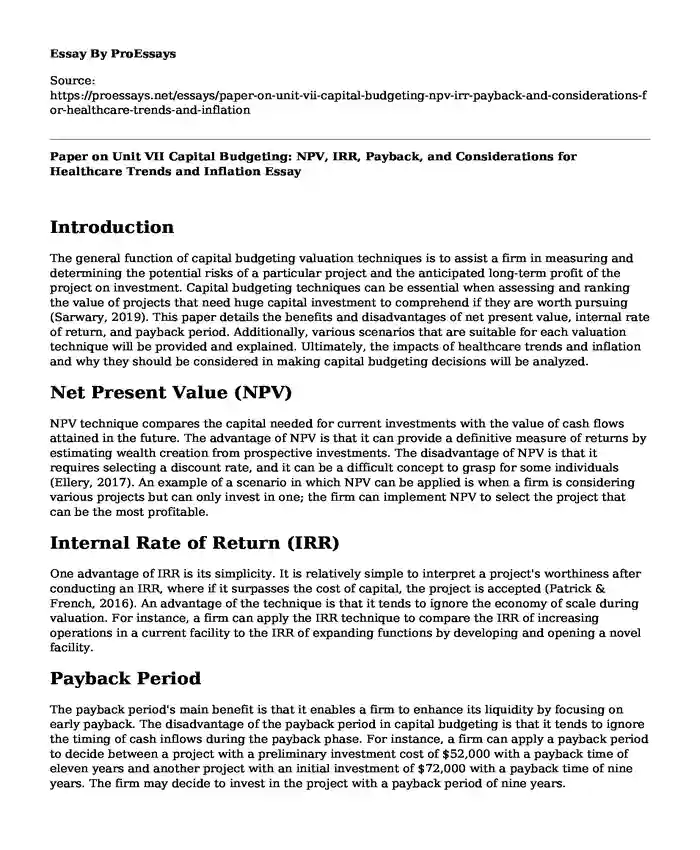Introduction
The general function of capital budgeting valuation techniques is to assist a firm in measuring and determining the potential risks of a particular project and the anticipated long-term profit of the project on investment. Capital budgeting techniques can be essential when assessing and ranking the value of projects that need huge capital investment to comprehend if they are worth pursuing (Sarwary, 2019). This paper details the benefits and disadvantages of net present value, internal rate of return, and payback period. Additionally, various scenarios that are suitable for each valuation technique will be provided and explained. Ultimately, the impacts of healthcare trends and inflation and why they should be considered in making capital budgeting decisions will be analyzed.
Net Present Value (NPV)
NPV technique compares the capital needed for current investments with the value of cash flows attained in the future. The advantage of NPV is that it can provide a definitive measure of returns by estimating wealth creation from prospective investments. The disadvantage of NPV is that it requires selecting a discount rate, and it can be a difficult concept to grasp for some individuals (Ellery, 2017). An example of a scenario in which NPV can be applied is when a firm is considering various projects but can only invest in one; the firm can implement NPV to select the project that can be the most profitable.
Internal Rate of Return (IRR)
One advantage of IRR is its simplicity. It is relatively simple to interpret a project's worthiness after conducting an IRR, where if it surpasses the cost of capital, the project is accepted (Patrick & French, 2016). An advantage of the technique is that it tends to ignore the economy of scale during valuation. For instance, a firm can apply the IRR technique to compare the IRR of increasing operations in a current facility to the IRR of expanding functions by developing and opening a novel facility.
Payback Period
The payback period's main benefit is that it enables a firm to enhance its liquidity by focusing on early payback. The disadvantage of the payback period in capital budgeting is that it tends to ignore the timing of cash inflows during the payback phase. For instance, a firm can apply a payback period to decide between a project with a preliminary investment cost of $52,000 with a payback time of eleven years and another project with an initial investment of $72,000 with a payback time of nine years. The firm may decide to invest in the project with a payback period of nine years.
Impacts of Healthcare Trends and Inflation
One effect of inflation on capital budgeting is that it tends to upsurge the real return rate to compensate, making it expensive for a firm to invest in specific projects. The impact of inflation can be eliminated from a capital budgeting evaluation by determining the real rate of return and applying it to calculate capital budgeting cash flow (Zurita et al., 2019). The increasing patient responsibility regarding medical expenses has reduced the amount of money generated by medical facilities. That has made hospitals focus on projects that collect more revenue from patients to avoid losses.
Conclusion
Capital budgeting methods can be significant when evaluating and ranking the value of projects requiring a considerable capital investment. Capital budgeting techniques can include IRR, payback period, and NPV. The main benefit of NPV is that it can issue a definite measure of returns through the estimation of wealth creation from prospective investments. Ultimately, the effect of inflation can be eliminated from capital budgeting evaluation by determining the real rate of return and applying it to calculate capital budgeting cash flow.
References
Ellery, A. A. (2017). Space Exploration Through Self-Replication Technology Compensates for Discounting in Net Present Value Cost-Benefit Analysis: A Business Case?. New Space, 5(3), 141-154.
Patrick, M., & French, N. (2016). The internal rate of return (IRR): projections, benchmarks, and pitfalls. Journal of Property Investment & Finance.
Sarwary, Z. (2019). Capital budgeting techniques in SMEs: A literature review. Journal of Accounting and Finance, 19(3).
Zurita, S., Castillo, A., & Niño, J. (2019). Inflation, tax integration, and company valuation: The Latin American case. Journal of Business Research, 105, 370-380.
Cite this page
Paper on Unit VII Capital Budgeting: NPV, IRR, Payback, and Considerations for Healthcare Trends and Inflation. (2024, Jan 10). Retrieved from https://proessays.net/essays/paper-on-unit-vii-capital-budgeting-npv-irr-payback-and-considerations-for-healthcare-trends-and-inflation
If you are the original author of this essay and no longer wish to have it published on the ProEssays website, please click below to request its removal:
- Paper Example on Child Development
- Essay Sample: Risk Analysis and Long-Term Investment Decisions
- Role of Care Homes Essay Example
- Paper Example on Effective Nursing Practice for Norovirus
- Paper Example on Form of Allergies
- Paper Example on Genetic Research: Exploiting Human DNA and Human Ethics.
- Free Paper Sample on Understanding HIV Prevalence in Botswana: Essential for Prevention Measures







